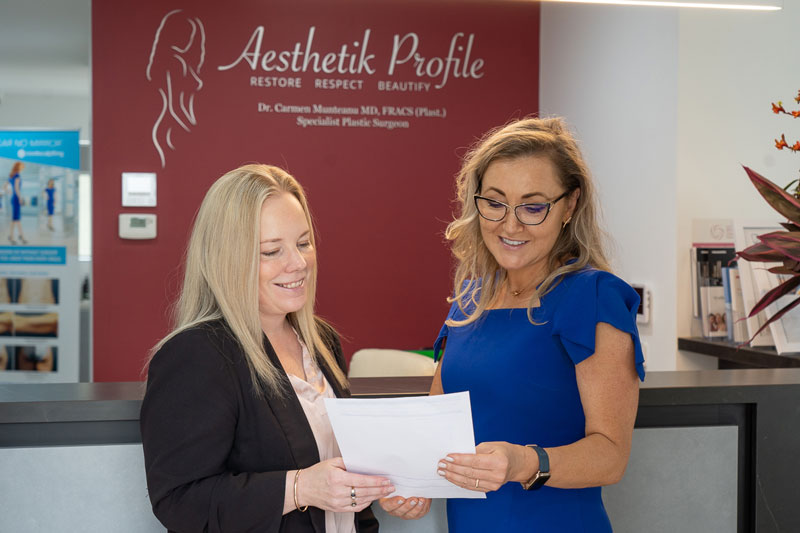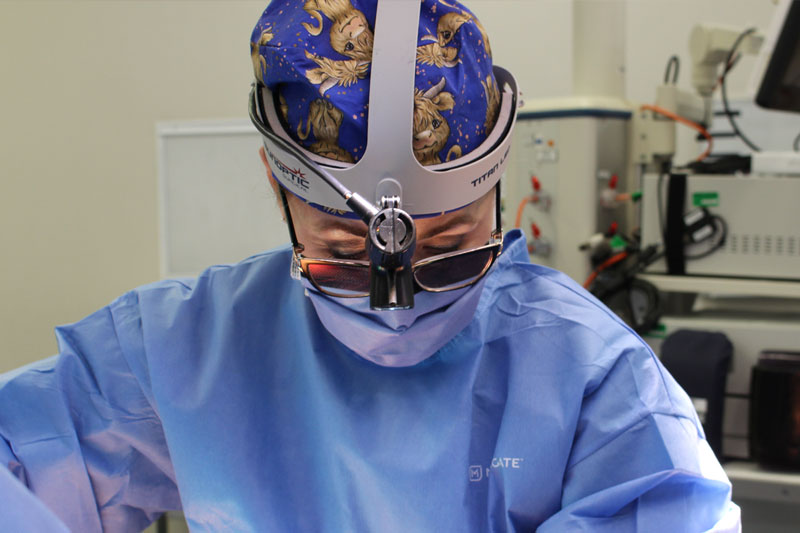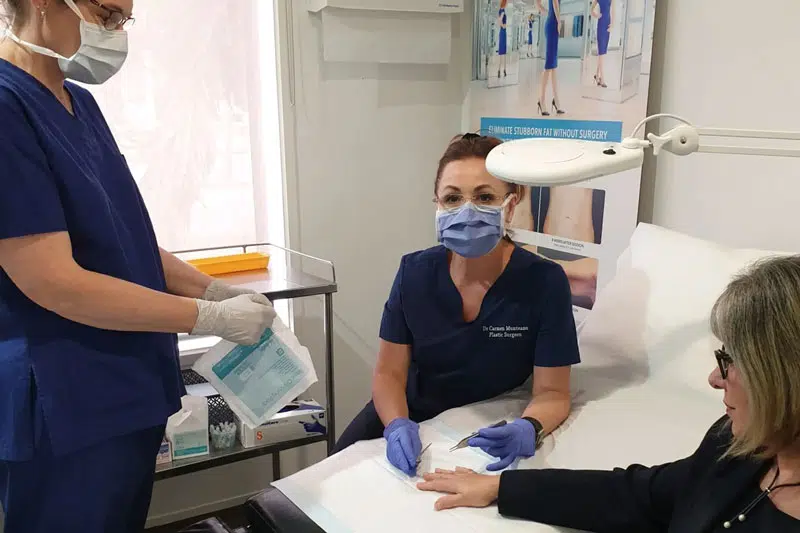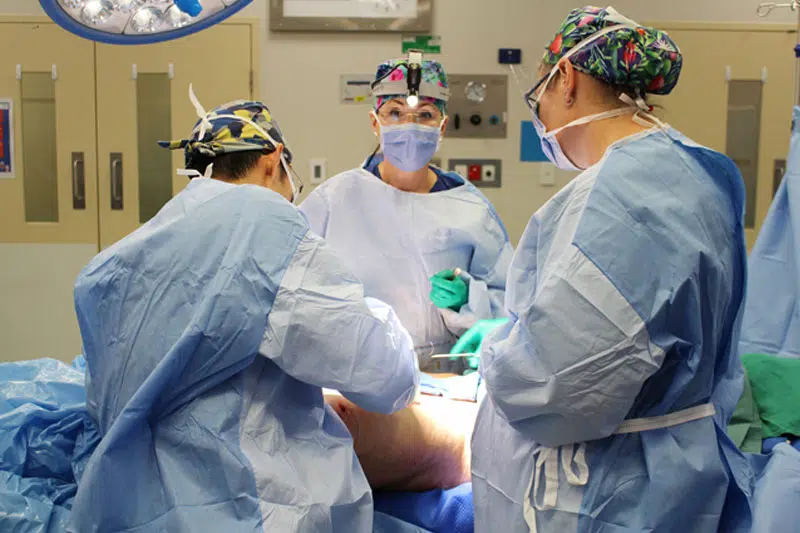Abdominoplasty, also known as a tummy tuck, is a surgical procedure that involves the removal of excess skin and fat from the abdominal area. It may also include the tightening of underlying muscles when appropriate.
Dr Carmen Munteanu is a Female Specialist Plastic Surgeon in Melbourne who performs abdominoplasty procedures for patients with concerns such as significant skin laxity, often following weight changes or pregnancy.
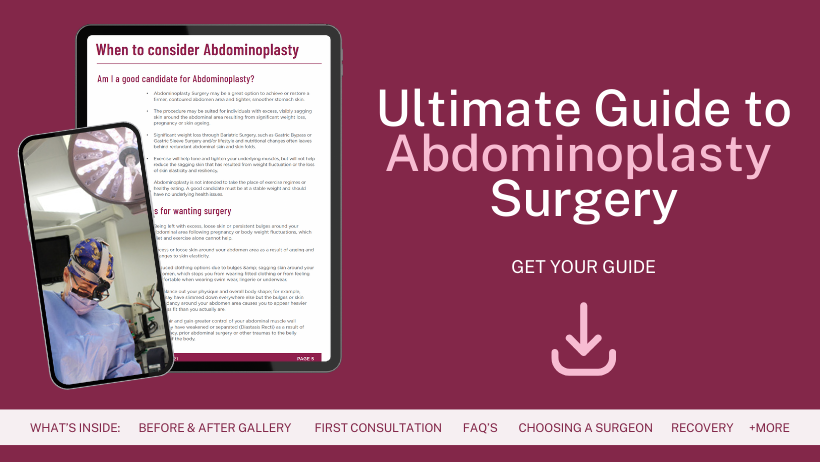
Download Dr Carmen’s Guide to
Abdominoplasty
Who is a Suitable Candidate for Abdominoplasty Surgery?
Abdominoplasty may be considered by individuals who have significant excess skin, localised fat deposits, or weakened abdominal muscles that do not respond to diet or exercise. This can occur due to factors such as pregnancy, significant weight loss, ageing, or previous surgeries.
A suitable candidate is typically:
- In good general health
- At or near a stable body weight
- A non-smoker (or willing to stop well before and after surgery)
- No medical conditions that may impair healing
- Realistic expectations about what surgery can and can not achieve
- Aware of the potential risks and complications of the procedure
The decision to proceed with surgery is made after a detailed consultation with a qualified Specialist Plastic Surgeon, like Dr Carmen who will consider your unique anatomy, medical history, and personal goals.
What are the Potential Benefits of a Tummy Tuck/Abdominoplasty?
Abdominoplasty can offer a range of potential benefits for suitable patients, including:
- Removal of excess skin: Particularly after significant weight loss or pregnancy, where stretched skin does not retract.
- Altered Abdominal Appearance: The procedure can alter the appearance of the abdomen resulting in a flatter more defined abdominal appearance. This is achieved by tightening the abdominal wall and removing loose tissue.
- Abdominal muscle separation (diastasis recti): This can occur after pregnancy or significant weight changes and may contribute to core weakness or discomfort. Surgery can alleviate this discomfort.
- Relief from some types of skin irritation: Excess skin can sometimes lead to rashes, chafing, or skin infections, especially in the folds.
- Posture or core stability: Strengthening the abdominal wall in some cases may contribute to increased postural support.
- Increased comfort/physical activity: By addressing excess tissue or skin, some individuals may find movement and exercise more comfortable.
- Facilitation of personal hygiene: Removing excess skin may ease cleaning and reduce the risk of trapped moisture and irritation.
These benefits vary between individuals and depend on several factors, including the technique used, the extent of tissue removal, and the patient’s overall health. Dr Carmen will provide a personalised assessment to determine whether Abdominoplasty is appropriate for your specific needs and circumstances.
Abdominoplasty Before and After Photos
Disclaimer: All before and after photos on this website feature actual patients who have undergone procedures performed by Dr. Carmen Munteanu, with their written consent for use. These images represent individual outcomes and may not reflect the results other patients will achieve. Factors such as genetics, overall health, and adherence to post-operative care can influence individual results. While these images provide a visual representation of potential results, they do not guarantee similar outcomes for all patients.

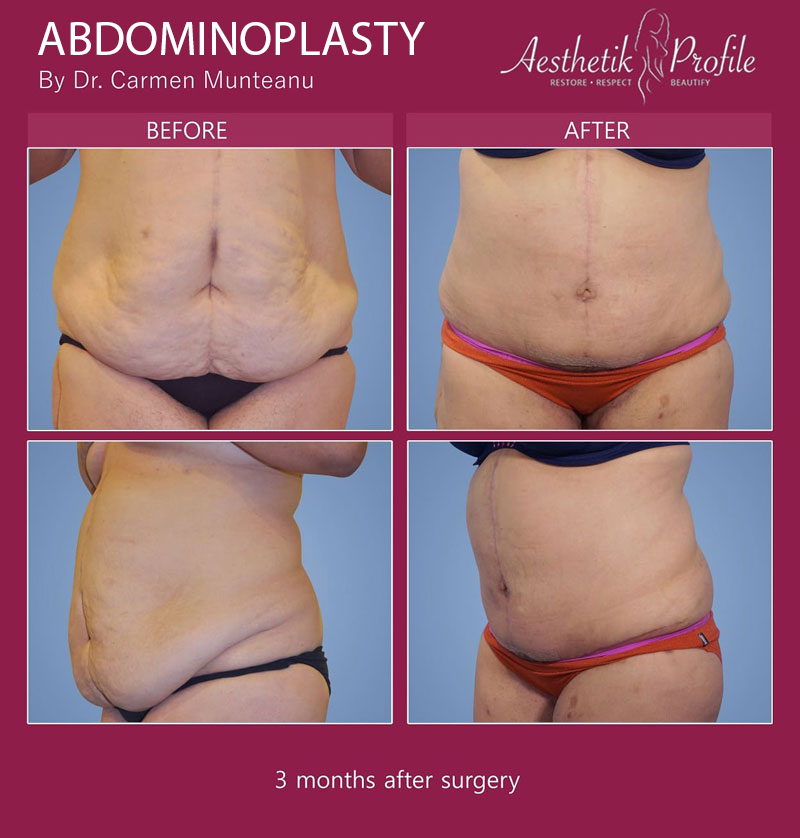
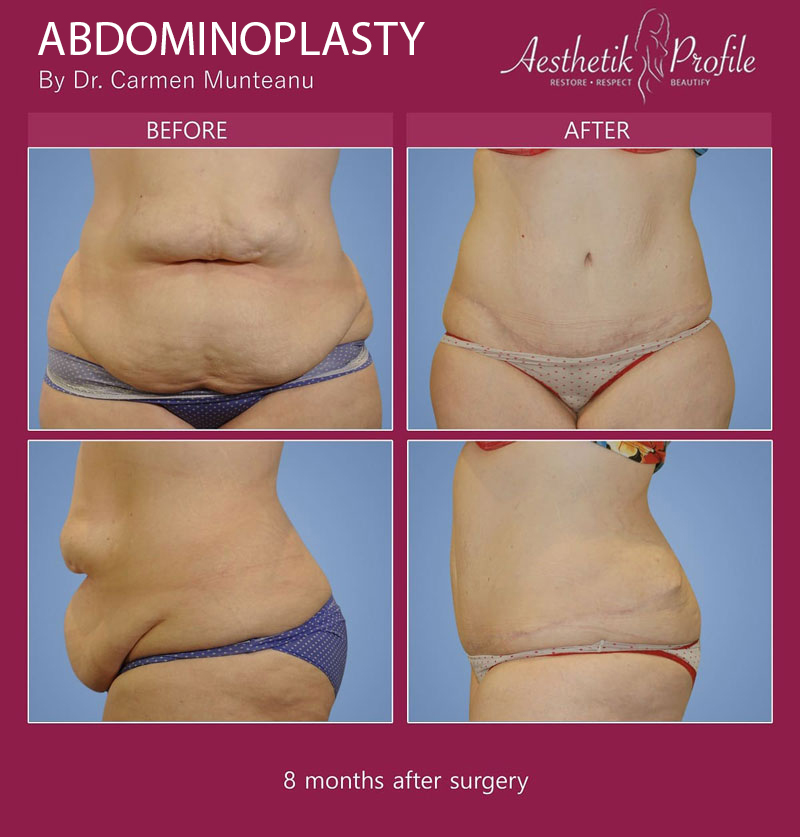
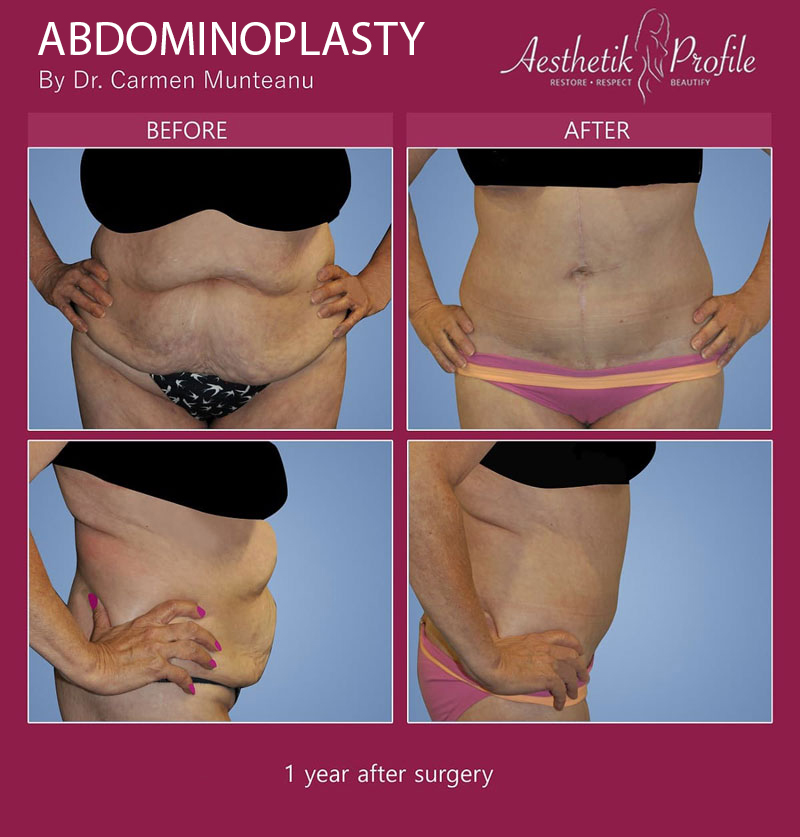
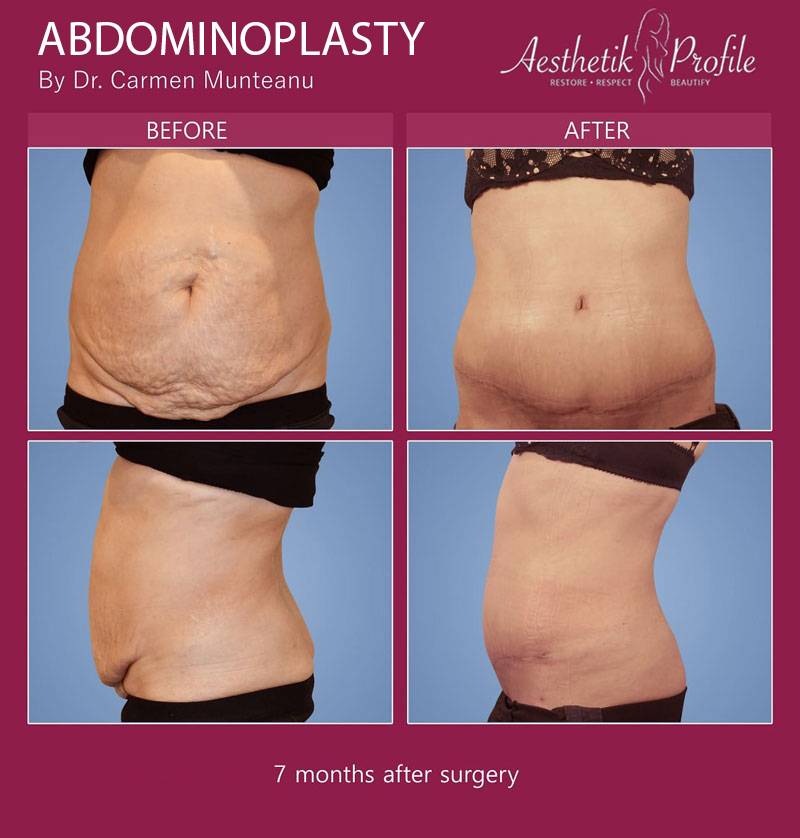
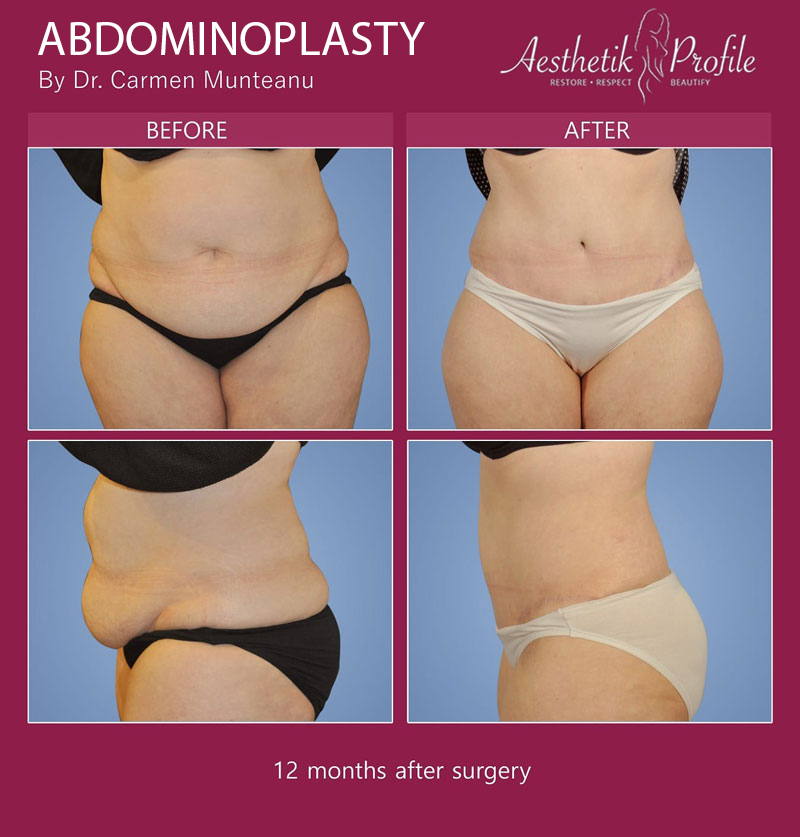
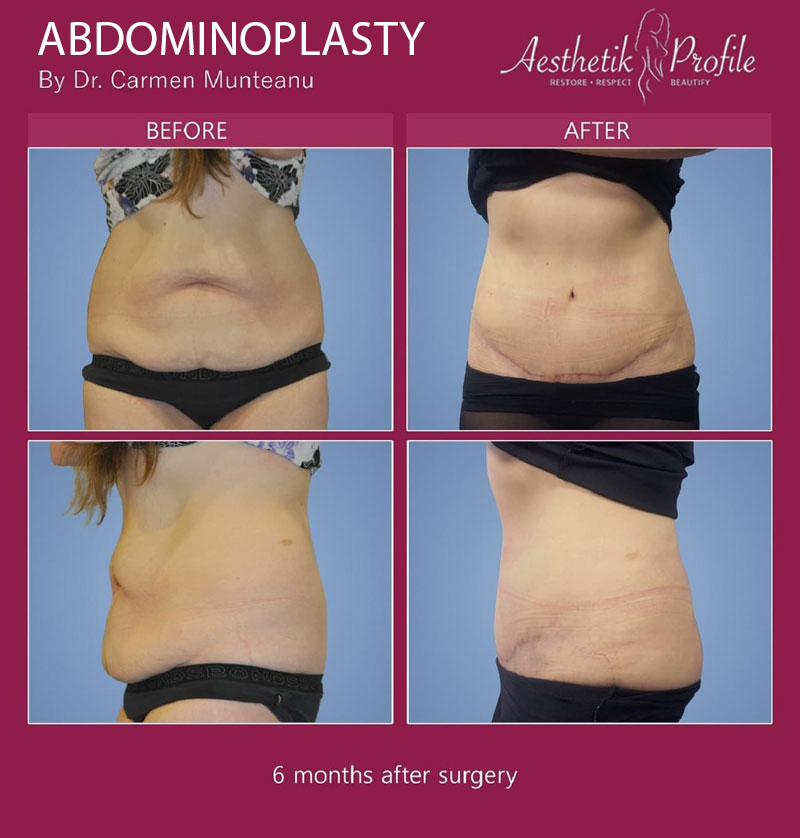
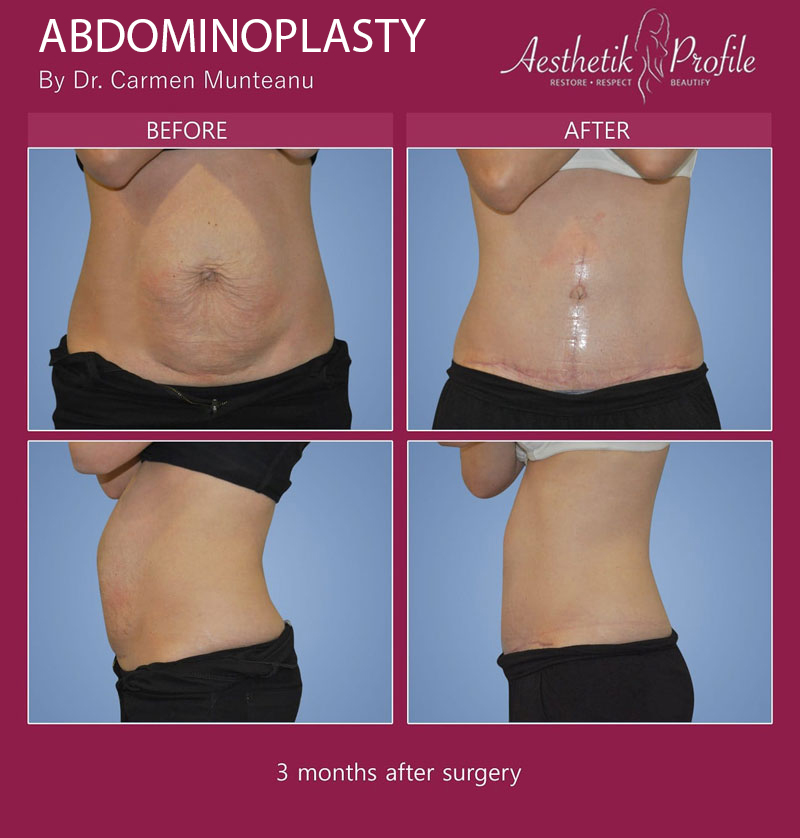
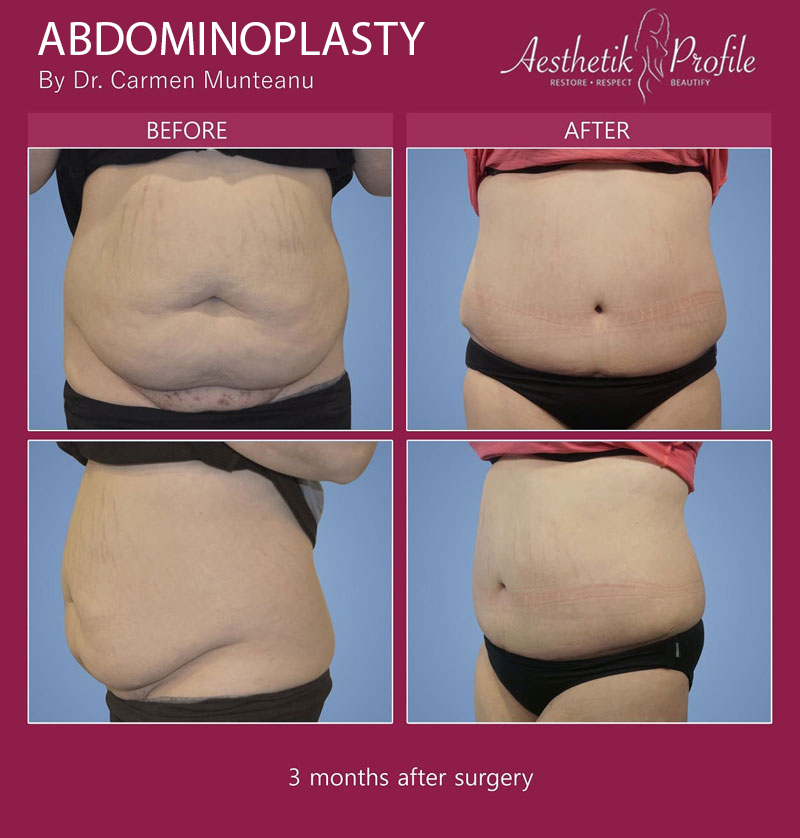
Visit the Photo Gallery to see more Photos
The Abdominoplasty Surgical Procedure
1. Anaesthesia
Medications will be provided for your comfort during the surgical procedure. Dr Carmen performs Abdominoplasty surgery using general anaesthesia. In other words, you will not be awake during the surgery.
2. The incision
During a full abdominoplasty, a horizontal incision is typically made along the lower abdomen. The length and placement of the incision will depend on the amount of excess skin being addressed. Once the skin is lifted, the underlying abdominal muscles may be tightened if required.
In some cases, a second incision around the navel may be needed to address excess skin in the upper abdomen. The upper skin is drawn downward, excess tissue is removed, and the remaining skin is repositioned and secured with sutures. A new opening is then made for the navel, which is brought through to its new position and stitched into place.
3. Closing the incisions
Sutures, skin adhesives, tapes or clips will close the skin incisions.
Risks and Complications of Abdominoplasty Surgery
All surgical procedures carry risks, and Abdominoplasty is no exception. During your consultation, Dr Carmen will explain these risks in detail and answer any questions you may have. Some potential risks and complications associated with Abdominoplasty include:
- Infection
- Bleeding or haematoma (collection of blood)
- Delayed wound healing
- Poor scarring, including the possibility of raised or widened scars
- Seroma (fluid accumulation beneath the skin)
- Changes in skin sensation, such as numbness or tingling near the incision area
- Asymmetry
- Anaesthetic-related complications
- Blood clots (deep vein thrombosis or pulmonary embolism)
- Necrosis (loss of skin or fat tissue, though rare)
It is important to follow all pre-operative and post-operative instructions to support healing and reduce the risk of complications. Dr Carmen and her team will provide personalised care throughout your surgical journey.
For more information please visit our risks of surgery page.
Post-operative care and follow-up
After Abdominoplasty surgery, patients will likely experience a feeling of tightness through the torso. Many patients find they are unable to stand fully upright for a short period following the procedure, however, this typically dissipates as healing progresses.
A hospital stay of approximately 2 to 4 days is generally required, depending on the extent of the procedure and individual recovery. Most patients are able to return to light work and daily activities within 2 to 4 weeks, though this timeframe can vary.
To support healing, it is recommended to avoid strenuous exercise, heavy lifting, and high-impact activities for at least 6 to 8 weeks. Dr Carmen will provide personalised post-operative instructions and schedule follow-up appointments to monitor your progress and recovery.
Longer-Term Results
The outcomes of Abdominoplasty can be long-lasting when supported by an active lifestyle. Factors such as ageing, weight fluctuations, and pregnancy can influence the long-term appearance of the abdominal area. While the surgical changes are considered long lasting, maintaining stable body weight and following post-operative advice can help support the durability of the outcome.
Dr Carmen provides ongoing follow-up care to monitor healing and provide guidance during the recovery period. Open communication and realistic expectations are essential for achieving and maintaining a satisfying result.
How much is an Abdominoplasty in Melbourne? Surgery Costs and fees
At your initial consultation, you will be given a detailed quote for your procedure. This will include a Surgeon’s fee, Anaesthetist fee, Surgical Assistant fee and the hospital fees.
Dr Carmen’s team will provide you a customised fee for your surgery depending on the type of procedure, hospital and how long you want to stay in hospital. An approximate fee range for your Abdominoplasty surgery can be provided over the phone when you speak to a Patient Care Advisor.
We also provide information on different methods of payment.
Find out more about Prices and Consultation Fees
Preparing for an Abdominoplasty
During your initial consultation, Dr Carmen Munteanu will listen to your concerns and expectations, discuss your age, health history, and risk factors.
You should be close to your target weight or health goals. This reduces complications and optimises your final result. If you are considering future pregnancies or have plans for significant weight loss, Dr Carmen will suggest postponing the surgery.
Find out more about your patient journey.
How painful is the Abdominoplasty procedure?
Discomfort is to be expected after Abdominoplasty, particularly in the first few days following surgery. Most patients describe the sensation as tightness or soreness in the abdominal area. Pain is generally manageable and is usually controlled with prescribed pain relief medication during the early recovery period.
The level of discomfort can vary depending on the individual, the extent of the procedure, and your personal pain threshold. Dr Carmen and her team will provide appropriate guidance and support to help you stay as comfortable as possible during the recovery process.

